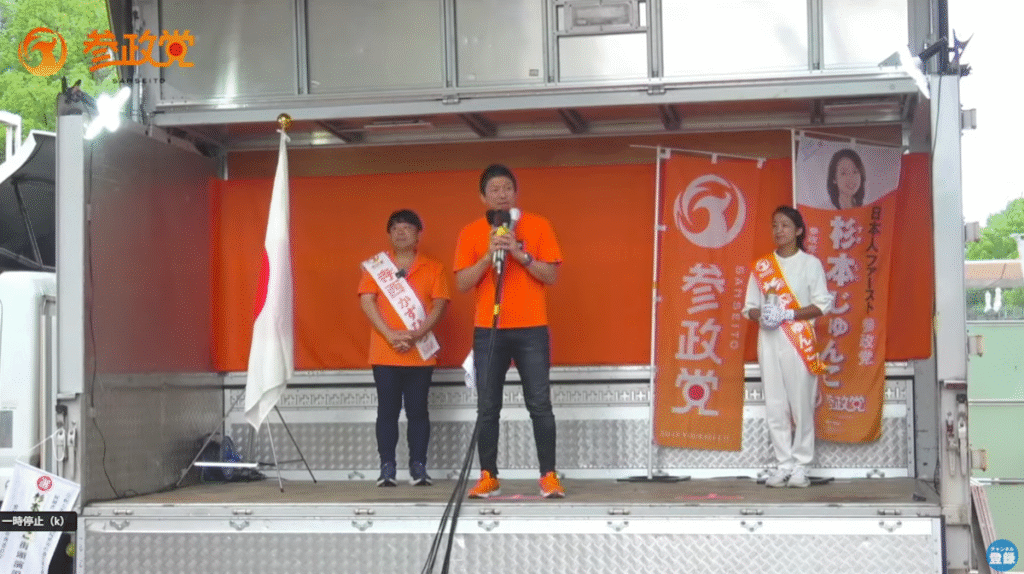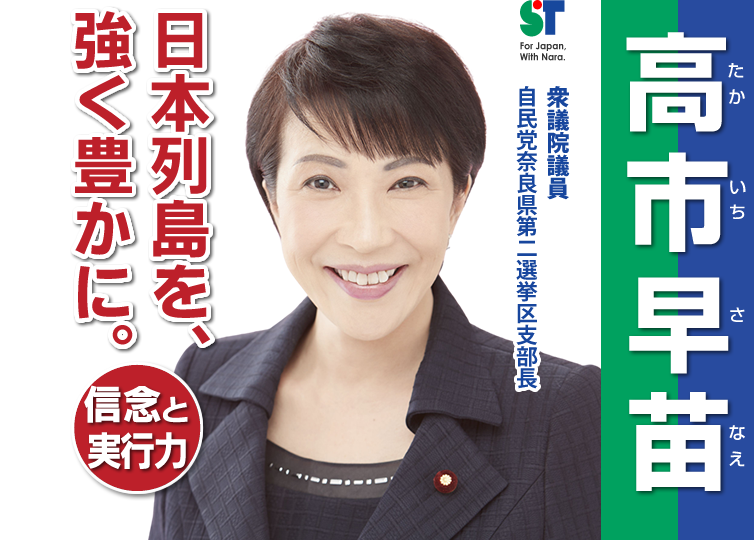Sanseitō is a far-right political party known for its “Japanese First” slogan during the election campaign. It also mimics the fascist tactics of U.S. President Donald Trump.
In May, ahead of the Upper House election, Sanseitō released its own draft Constitution and called for “creating a new constitution.” The proposal echoes the historical slogan to “Revere the Emperor, expel the barbarians” (sonnō jōi). It is a late Edo period phrase stressing loyalty to the Emperor and resisting foreign influence.
Table of Contents
ToggleSanseitō’s proposed Constitution embeds the spirit of “Revere the Emperor”

Sanseitō’s draft for a “New Japanese Constitution” places strong emphasis on the idea of “Revere the Emperor.” This phrase comes from the historical slogan “Revere the Emperor, expel the barbarians” (sonnō jōi). The emphasis is clear in Chapter 1, Article 1. “Japan is a nation ruled by the Emperor and united as one with its people.”
This phrase portrays the Emperor as a ruling figure, not just a symbol. It sharply contrasts with Japan’s current Constitution—Chapter 1, Article 1—which defines the Emperor as “the symbol of the State and of the unity of the People, deriving his position from the will of the people with whom resides sovereign power.”
Article 1 of the proposed Constitution also reinforces the Emperor’s sacred nature. It describes him as “a sacred figure who prays for the happiness of the people and must not be violated.” This wording evokes the image of a living deity, reminiscent of prewar ideology rejected after World War II. It aligns more closely with the spirit of the Meiji Constitution than with Japan’s current legal framework.
Article 3 expands the Emperor’s role further. It designates the Emperor as head of state and gives him authority to approve key national matters under Cabinet responsibility. If the Cabinet submits the same matter again, the Emperor must approve it. This clause introduces a level of political involvement not found in the current Constitution’s Article 4. It explicitly states the Emperor “shall not have powers related to government.”
The most controversial point lies in Article 1. Declaring that Japan is “ruled by the Emperor” suggests a shift in sovereignty from the people back to the throne. This marks a clear departure from the postwar principle of popular sovereignty and is likely to draw significant debate.
“Expel the barbarians”: Sanseitō’s proposed Constitution embraces anti-foreigner policies
Sanseitō’s proposed “New Japanese Constitution” includes provisions that strongly reflect the slogan “expel the barbarians.” This phrase called for resisting and removing foreign influence, and the draft reveals clear anti-foreigner sentiment.
In Chapter 3, Article 14 states, “The state shall take necessary measures to ensure that local governments are not subject to interference from foreign countries or international organizations.” This frames foreign entities as threats to domestic autonomy and urges blocking any external involvement.
The sentiment intensifies in Chapter 4, particularly in Article 19. It begins with, “The state shall have the sovereign right to freely determine the conditions for the entry and residence of foreign nationals.” This signals a move toward stricter immigration control.
The clause “Land is public property and shall not be transferred to foreign nationals or foreign capital” takes a hardline protectionist stance. It treats foreign ownership as a national risk. Another provision allows the state to “confiscate such property or repurchase it with just compensation”—a power that raises concerns over property rights and investor protections.
Planning a trip to Japan? Get an authentic, interpreted experience from Unseen Japan Tours and see a side of the country others miss!

"Noah [at Unseen Japan] put together an itinerary that didn’t lock us in and we could travel at our own pace. In Tokyo, he guided us personally on a walking tour. Overall, he made our Japan trip an experience not to forget." - Kate and Simon S., Australia

See a side of Tokyo that other tourists can't. Book a tour with Unseen Japan Tours - we'll tailor your trip to your interests and guide you through experiences usually closed off to non-Japanese speakers.


Want more news and views from Japan? Donate $5/month ($60 one-time donation) to the Unseen Japan Journalism Fund to join Unseen Japan Insider. You'll get our Insider newsletter with more news and deep dives, a chance to get your burning Japan questions answered, and a voice in our future editorial direction.
Article 19 further excludes foreigners from political life. It states, “Foreign nationals shall not be granted suffrage or eligibility to run for public office,” and “Naturalized citizens shall not be permitted to hold public office until three generations have passed.” This provision sets an ethnically and culturally exclusive standard for civic participation. It suggests that even naturalized individuals remain outsiders.
This exclusionary stance is also reinforced in Article 5. It states, “The requirements for being a national shall be defined by law, based on whether the father or mother is Japanese, whether Japanese is the person’s native language, and whether they have a heart that values Japan.” It does not explicitly say that naturalized citizens are not Japanese nationals. However, by tying nationality to having a Japanese parent and Japanese as a native language, Article 5 would likely exclude most naturalized citizens from being regarded as Japanese nationals.
Together, these provisions mark a clear departure from liberal democratic norms and reflect a nationalist framework rooted in fear of foreign influence.
Breaking with Article 9: Sanseitō proposed Constitution would restore military powers

Chapter 4 of Sanseitō’s proposed Constitution outlines the creation of a “Self-Defense Military,” echoing elements of prewar ideology.
Article 20 of Chapter 4 states, “The state shall maintain a military for the purpose of self-defense (hereinafter referred to as the ‘Self-Defense Military’).” This signals a move away from Article 9 of the current Constitution, the famous “renunciation of war” clause.
The use of the term “military” and the clause, “A military court shall be established, and its structure shall be defined by law,” indicate a return to prewar systems. These include military tribunals abolished after World War II.
The clause, “The Prime Minister shall hold supreme command over the Self-Defense Military,” shows strong centralization of authority. It may also imply reduced reliance on the U.S. military, although the draft does not explicitly address the U.S.-Japan alliance.
Article 20 also states, “The exercise and termination of the right to self-defense shall require approval from the National Diet. However, in cases of unavoidable emergency, such approval may be obtained retroactively.” This framework reaffirms civilian control by placing authority in the hands of elected leaders. At the same time, it restores Japan’s ability to act independently in defense.
Sanseitō’s proposed Constitution signals a dramatic ideological shift. It revives reverence for the Emperor, rejects foreign influence, embraces anti-foreigner sentiment, and calls for rearmament. While framed as a path toward national self-reliance, the draft appears to diverge from the democratic principles Japan has upheld since the end of World War II.
Significant rights guaranteed by current Constitution missing from Sanseitō’s draft

The proposal leaves out several rights that are clearly stated in Japan’s current Constitution. One example is the right to equality, guaranteed under Article 14. The article states, “All people are equal under the law and there shall be no discrimination in political, economic or social relations because of race, creed, sex, social status or family origin.” This principle bans discrimination based on gender or birthplace.
Article 14 has also been the basis for addressing issues such as the vote-value disparity in elections and the now-abolished civil law that barred women from remarrying within 100 days of divorce. Yet Sanseitō’s draft Constitution does not include any clause guaranteeing this fundamental equality under the law.
Planning a trip to Japan? Get an authentic, interpreted experience from Unseen Japan Tours and see a side of the country others miss!

"Noah [at Unseen Japan] put together an itinerary that didn’t lock us in and we could travel at our own pace. In Tokyo, he guided us personally on a walking tour. Overall, he made our Japan trip an experience not to forget." - Kate and Simon S., Australia

See a side of Tokyo that other tourists can't. Book a tour with Unseen Japan Tours - we'll tailor your trip to your interests and guide you through experiences usually closed off to non-Japanese speakers.


Want more news and views from Japan? Donate $5/month ($60 one-time donation) to the Unseen Japan Journalism Fund to join Unseen Japan Insider. You'll get our Insider newsletter with more news and deep dives, a chance to get your burning Japan questions answered, and a voice in our future editorial direction.
Another set of rights missing from the draft are key freedoms guaranteed in the current Constitution. Articles 19 to 22 protect fundamental rights: freedom of thought and conscience under Article 19, freedom of religion under Article 20, freedom of expression under Article 21, and freedom of residence, movement, occupation, and renunciation of nationality under Article 22. These rights allow people to hold any belief, practice any religion, choose their profession, and decide where to live or move. Article 21 is particularly significant, as it arose from wartime censorship. It protects freedom of speech, including criticism of authority, and bans government censorship. None of these rights appear in Sanseitō’s draft of the Constitution.
The draft also omits protections for criminal procedure rights found in Articles 31 to 40. These provisions guarantee the rights of suspects and defendants. Article 32 ensures the right to a trial, while Article 36 bans torture. These protections stem from reflection on serious human rights violations before World War II. In contrast, Sanseitō’s draft lacks any clauses safeguarding such rights. It removes the right to a trial and the right to remain silent.
Sanseitō’s Kamiya Sohei stated in a commentary book he edited that “individual rights are nothing more than private interests,” and this belief appears to underpin the party’s proposed Constitution.
Why this page doesn't look like crap
You may notice a few things about this page. First, it’s mostly content – not ads. Second, this article was written by a human, not a plagiaristic Turing machine.
Unseen Japan is a collective of independent authors. We work hard to keep our content free of intrusive ads and AI slop.
Help us keep it that way. Donate to the Unseen Japan Journalism Fund to support our work. Regular donors will receive Insider, our paid newsletter with weekly bonus content about Japan. Plus, your contribution will help us produce more content like this.
What to read next

“Honorary Man”: Takaichi Sanae Scorned, Shunned by Japanese Feminists
The woman who may be Japan’s first prime minister is under fire for her “fossil-like thinking” on women’s rights.

Saitama Lawmaker States Foreigners in Japan Have “No Fundamental Human Rights”
The lawmaker later backtracked on the statement, saying that he only meant they didn’t have “the same rights” as Japanese citizens.

Japanese Politician Says Tourists Are Kicking Nara’s Deer. But Where’s Her Evidence?
Are foreigners mistreating the deer in Nara? One prominent Japanese politician says so – but the facts don’t back her up.
Sources
参政党が創る 新日本憲法 (構想案) 参政党
The Constitution of Japan. The Prime Minister of Japan and His Cabinet
今の憲法にはあるのに?参政党の創憲案で消された私たちの「権利」 毎日新聞
“参政党の憲法草案”に専門家「日本国憲法の方が100倍いい」「憲法で報道機関を縛れるのは中国・北朝鮮、そういう非民主主義国家しかない」ABEMA Times
<1分で解説>参政党が神奈川新聞記者を記者会見から排除 背景は. Mainichi Shimbun


